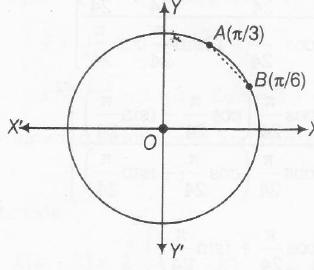Answer:
Option A
Explanation:
Parametric equations of given circle is x=12cosθ, y=12sinθ
[∵ Parametric equation x2+y2=r2 is x=rcosθ,y=rsinθ]
Now, coordinates of point A are given by
x=12cosπ3,y=12sinπ3
⇒ x=12.12,y=12.√32
⇒ x=6;y=6√3
ie, A=(6,6√3)

and coordinates of point B are given by
x=12cosπ6,y=12sinπ6
⇒ x=12.√32.y=12.12
⇒ x=6√3,y=6
i.e, B=(6√3,6)
Clearly , length of chord
AB=√6(√3−6)2+(6−6√3)2
=√2×62+(√3−1)2
=6√2(√3−1)
=6(√6−√2)